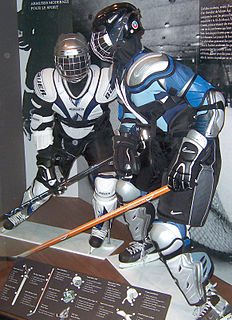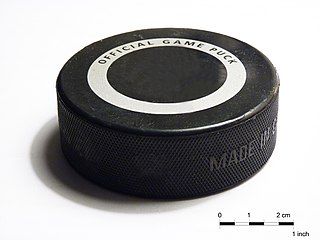 W
WIn ice hockey, players use specialized equipment both to facilitate the play of the game and for protection as this is a sport where injuries are common, therefore, all players are encouraged to protect their bodies from bruises and severe fractures.
 W
WThe goalie blocker is a rectangular piece of equipment worn by ice and roller hockey goaltenders. It is generally worn on the dominant hand.
 W
WElbow pads are protective padded gear worn on the elbows to protect them against injury during a fall or a strike.
 W
WA face shield, an item of personal protective equipment (PPE), aims to protect the wearer's entire face from hazards such as flying objects and road debris, chemical splashes, or potentially infectious materials.
 W
WThere are three styles of gloves worn by ice hockey players. Skaters wear similar gloves on each hand, while goaltenders wear gloves of different types on each hand.
 W
WA goaltender mask, commonly referred to as a hockey mask or a goalie mask, is a mask worn by ice hockey, inline hockey, field hockey, bandy and floorball goaltenders to protect the head from injury. Jacques Plante was the first goaltender to create and use a practical mask in 1959. Plante's mask was a piece of fiberglass that was contoured to his face. This mask later evolved into a helmet-cage combination, and single piece full fiberglass mask. Today, the full fiberglass mask with the birdcage facial protector is the more popular option, because it is safer and offers better visibility.
 W
WIn ice hockey, the goaltender wears specialized goaltending equipment to protect himself from the impact of the puck and to assist himself in making saves.
 W
WA hockey helmet is worn by players of ice hockey, inline hockey, and bandy to help protect the head from potential injury when hit by the puck, sticks, skates, boards, other players, or the ice. The shell of a hockey helmet is generally made of a substance called vinyl nitrile that disperses force from the point of contact, while the liner may be made of either vinyl nitrile foam, expanded polypropylene foam, or other material to absorb the energy, to reduce the chances of concussion. Hockey helmets grip the head from inside by cupping the back of head, or the occipital protuberance. Helmet manufacturers will have a chart that relates their helmet sizes to head measurements. Mt on older models, the helmet size is adjusted by loosening the screws on the side to slide the front portion forward or back.
 W
WA hockey jersey is a piece of clothing worn by ice hockey players to cover the upper part of their bodies. It is traditionally called a sweater as, in earlier days, when the game was predominantly played outside in winter, it actually was a warm wool-knit covering.
 W
WIce skates are metal blades attached underfoot and used to propel the bearer across a sheet of ice while ice skating.
 W
WHockey socks are ankle-to-thigh garments worn over protective gear by ice hockey players. They are form-fitting, and traditionally made of a cotton or synthetic rib-knit fabric. Experiments have been made with a lightweight fabric "sock," of material similar to that used in hockey jerseys, and most recently (mid-2000s) with a streamlined lightweight "sock" used by the U.S. Olympic and other international teams. Hockey socks should not be confused with hockey skate socks which are thin, traditional style socks worn over the foot.
 W
WThere are several kinds of hockey tape used by ice hockey, field hockey, roller hockey, and lacrosse players: stick tape, shin pad tape and grip tapes.
 W
WMarsh Pegs is a goal anchoring system for ice hockey designed by Fred Marsh. The pegs have been used by the NHL since 1991.
 W
WA neck guard is a piece of protective equipment worn by an ice hockey player around the neck area. The guard is designed to prevent injury to the neck by pucks, hockey sticks, and skate blades.
 W
WPads are protective equipment used by batters in the sport of cricket, catchers in the sports of baseball and fastpitch softball, and by goaltenders in ice hockey, bandy and box lacrosse. They serve to protect the legs from impact by a hard ball or puck at high speed which could otherwise cause injuries to the lower legs.
 W
WA hockey puck is a disk made of vulcanized rubber that serves the same functions in various games as a ball does in ball games. The best-known use of pucks is in ice hockey, a major international sport. A hockey puck has also been referred to as a "Flat Ball."
 W
WAn ice resurfacer is a vehicle or hand-pushed device used to clean and smooth the surface of a sheet of ice, usually in an ice rink. The first ice resurfacer was developed by American inventor and engineer Frank Zamboni in 1949 in the city of Paramount, California. As such, an ice resurfacer is often referred to as a "Zamboni" regardless of brand or manufacturer.
 W
WResurfice Corporation is a manufacturer of ice resurfacing equipment based in Elmira, Ontario, Canada. Their Olympia brand product line includes push models through full size models built on a Chevy Powertrain. In early 2009, Don Schlupp, the company's director of sales and marketing, said that the company had about a 70% share of the market in North America, but later that year the company said it produces about the same number of machines as Zamboni.
 W
WA shin guard or shin pad, is a piece of equipment worn on the front of an athlete's shin to protect it from injury. These are commonly used in sports including association football, baseball, ice hockey, field hockey, lacrosse, cricket, mountain bike trials, and other sports. This is due to either being required by the rules/laws of the sport or worn voluntarily by the participants for protective measures.
 W
WIce skates are metal blades attached underfoot and used to propel the bearer across a sheet of ice while ice skating.
 W
WA skatemill is a practice utility machine for ice hockey professional players to improve their skating techniques, which is very important to achieve the level of skating ability to play on an NHL team.
 W
WAn ice hockey stick is a piece of equipment used in ice hockey to shoot, pass, and carry the puck across the ice. Ice hockey sticks are approximately 150–200 cm long, composed of a long, slender shaft with a flat extension at one end called the blade. National Hockey League (NHL) sticks are up to 63 inches long. The blade is the part of the stick used to contact the puck, and is typically 25 to 40 cm long. Stick dimensions can vary widely, as they are usually built to suit a particular player's size and preference. The blade is positioned at roughly a 135° angle from the axis of the shaft, giving the stick a partly 'L-shaped' appearance. The shaft of the stick is fairly rigid, but is slightly elastic to improve shot performance.
 W
WA trapper, also referred to as catch glove or simply glove, is a piece of equipment that an ice hockey goaltender wears on the non-dominant hand to assist in catching and stopping the puck.